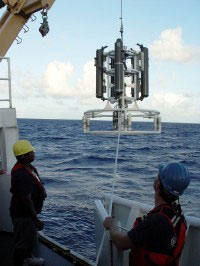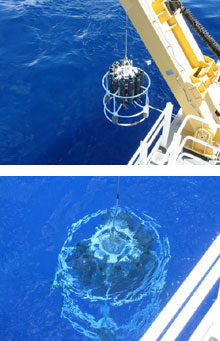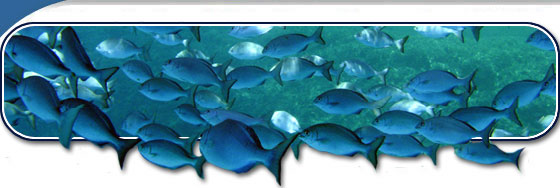Error processing SSI file
|
A Good Day for Science
By Joe Chojnacki, NOAA
It’s 6:30 am, if I set the alarm clock properly last night. With the ship rolling beneath me I swing down from my top bunk assisted by blurry eyes and stiff joints, maybe the most dangerous part of my day. My cabin-mate is a ship’s officer and he’s already on his watch up on the bridge, taking a turn at the helm. In keeping with the fashion-sense of the ocean-going community, I look in the mirror, mash down the worst of my bed-head and dress for the day ahead. For this part of the cruise I’m doing CTD casts (using sensors that measure conductivity, temperature, and depth) so I wear running shoes, board shorts, and a T-shirt. Time for breakfast.
 |
| Researchers lower the CTD sensors into the ocean. These sensors measure conductivity, temperature and depth (CTD). |
There’s only a gentle roll right now; the weather’s been pretty forgiving for these latitudes at this time of year. Even so, the heavy doors are hard to open if the ship is rolling in the opposite direction. I wait a second for the roll, shoulder the door open, use both hands to get down the steep steps in one piece, and I’m that much closer to being awake.
With food in my belly and coffee in hand I head aft to the wet lab, where the night crew of the CTD team is just finishing up processing their last samples. I open the door and punk rock hits me like cold water in the face. Awake at last. At the end of a 12-hour shift, the night crew is running on fumes and the crushing guitar pumping out of someone’s iPod. The vacuum pump is sucking the last few liters of water through the filters, trapping the chlorophyll for later analysis. In a few minutes they’re done, off to have breakfast and hit the sack. Our turn.
What we’re doing is lowering a bundle of oceanographic sensors and water sample bottles over the side of the ship to a depth of 500 meters. The sensors measure conductivity, temperature, and depth (CTD), as well as chlorophyll levels and dissolved oxygen, once per second as the instruments descend steadily though the water column. These sensors return depth profiles of all these various measurements, which give us an indication of the water’s salinity, biological productivity, and other indicators of oceanographic processes. By monitoring these various parameters, we hope to identify the transition point between warm, nutrient-poor tropical waters and colder, nutrient-rich waters. It’s thought that the front separating these bodies of water is where the marine debris collects; we’ll see.
Our survey plan is to do CTD casts and take water samples every 15 minutes of latitude, or 15 nautical miles. At the ship’s top speed of 10 knots, or 10 nautical miles per hour, it’s about an hour and a half of travel between casts.
The first order of business is to swap iPods. Proper ambiance is crucial for reliable science. It doesn’t take long before we’re on station at the next survey site, and with old 80s gems rocking out of the speakers, it’s go time. The ship’s officers on the bridge put the helm hard over, sending the ship into a ‘power slide’. The equivalent of a skier coming to a halt at the bottom of a run, presenting the entire length of the ship to the oncoming water is a quick way to check the ship’s speed. As the ship slides sideways, it flattens the ripples out of a wide swath of water. The 224-foot ship skidding in slow motion through the waves displaces a huge volume of water, and slow billows of water rise and flatten the surface into a smooth, glassy pool bounded by the Sette on one side and a semicircle of rippled waves on the other.
Wearing hardhats and PFDs (personal flotation devices, or life jackets), we double-check that the bleeder valves on the water sample bottles are closed, unclip the tie-downs securing the CTD to the deck, and wait for the word from the bridge. “Survey, Bridge,” squawks the radio. “Go ahead, Bridge,” replies Elaine Stuart, Senior Survey Tech on the Sette. “We are all stop,” says the officer on duty, “You are clear to start CTD operations.” Elaine: “Copy, Bridge. Request permission to put the CTD in the water.” Bridge: “Go ahead, Survey.”
 |
| The CTD sensors in action. (Photos: Curtis Olsen) |
We open the doors built into the ship’s rail (the side of the ship), and when everyone’s ready Lester Scott, the ship’s crewmember at the winch controls, hoists the CTD up and over the side, then lowers it into the water. Elaine sits at the computer inside the ship monitoring the data collection. Based on the data, she directs Lester to use the winch to raise and lower the CTD. At 200 meters, Elaine sends a signal from her computer to the CTD which triggers the release of the first bottle’s stoppers, trapping water inside. She repeats this at 150, 125, 100, 80, 65, 50, 35, 20 meters, and finally at the surface, giving us samples of the water at 10 different depths. Twenty minutes later, with water samples and complete profiles of all the data, the CTD is strapped back down to the deck. With winch operations finished and the doors closed, we take off our hard hats and PFDs, open the bleeder valves on the water bottles, and start filling smaller sample bottles from the large ones mounted on the CTD.
Each large CTD bottle is used to fill a 2-liter bottle, a 1-liter bottle, and a 30-milliliter bottle. With all the bottles filled, we’ll have 30 in all, and not a lot of time to process them. So as soon as the first bottles are filled I collect them and take them into the wet lab, where we have a water filtration system set up. A vacuum pump sucks water through five sets of pipes. A funnel is screwed to the end of each pipe, holding a new filter in place. I turn the pump on, pour water from the five bottles I brought with me into the five funnels, and open the valves to let the water start flowing. Each funnel only holds about 200mL of water, so it takes several fills to run the whole bottle through the filter.
These water samples are meant to provide further detail about how much and what type of organisms are living in the ocean’s top 200 meters. Each depth will have a slightly different level of chlorophyll, the same light-gathering molecule that makes our trees green, and whatever’s left on the filters after sucking a liter of water through it will tell us exactly how much. Since each water sample came from a different depth, it’s important to keep track of which bottle is being poured through which filter; otherwise we’ll get improper readings when the filters are analyzed after the cruise.
Once all the 1-liter bottles are processed, we do the same thing with the 2-liter bottles. This will give us another set of filters covered in twice as much chlorophyll and other energy-producing molecules known as chloropigments. This larger sample will be used to figure out exactly how much of each kind of chloropigment there is in the water. Since we already know what types of organisms contain which type of chloropigment, we can use these filters to tell us what kinds of organisms are living in the water.
All of this may seem like a strange activity to be doing on a marine debris cruise, but the distribution of chlorophyll in the water column is very different between tropical (warm) and temperate (cold) waters due to higher levels of nutrients in temperate surface waters. As we travel north the chlorophyll levels suddenly increase marking the transition from tropical to temperate waters, sometimes referred to as the chlorophyll front. It’s thought that marine debris congregates along this front, too. Computer models that crunch ocean wind and current data show that winter storms around Alaska, Russia, and Japan push the surface water south toward warmer waters, and we’re out here to see whether the predictions are right that floating marine debris collects along this front. So filtering water is supposed to help us find the chlorophyll front, and hopefully the tons of marine debris that we know are out here somewhere.
Back in the wet lab, others are coming in with full bottles. The 30mL bottles all go straight to the freezer; they’ll be used to analyze nutrient levels in the water after we return to port. The remaining bottles get lined up, waiting to be poured through filters. But right now the last drops of water from the first bottles are being sucked through the filter. It’s time to collect the filter and get another bottle started, and two more bottles are almost sucked dry. By now Kyle Koyanagi and Russell Reardon, the other scientists who are on my shift, have brought more of the bottles inside and have jumped in to help change the first set of filters. So as I spray the sides of my empty funnel with deionized water to make sure all the chlorophyll gets washed through the filter, Russell tends to the continual process of keeping the funnels full of water, and Kyle grabs a new, full water bottle and prepares a clean filter. I close the valve on my drainpipe, unscrew the funnel, and use tweezers to fold the filter - wet and slightly greenish now – in half. As I wrap the filter in a pre-labeled piece of tin foil, Kyle is placing the new filter on the now-empty drainpipe and locking it in place with the funnel, and Russell is rinsing out the two funnels that have just emptied. Elaine comes into the wet lab with the last of the bottles, and notices that one of the funnels is running dry. She picks up the bottle next to the filter, and fills the funnel back up.
Like chefs on a kitchen line at a busy restaurant, we’re constantly reaching around each other, anticipating each other’s needs, and setting up our coworkers with what they need next. As I spin from my station to fold another filter in foil, Kyle steps into my place to keep all the funnels full while Russell changes another filter and Elaine lines up the pieces of foil for us. It’s a constant dance to keep the process running smoothly. You can imagine it was pretty chaotic on our first day, but once we got the hang of working together (during the intro to Boston’s “More Than a Feeling”, I believe) there was no stopping us.
When the bottles are all filtered, and the filters all wrapped, we bundle them up in a larger piece of foil and drop them into a container of liquid nitrogen, preserving the samples until they can be analyzed. We look at the computer monitor in the wet lab to see what the ship’s latitude is… 25 degrees, 54 minutes North. Only six minutes of latitude, or six nautical miles, until our next CTD cast. We’re going a breakneck 11 knots now, which gives us about a 30 minute break. Just time to make a cup of coffee, write a bit in my journal, and maybe respond to an e-mail. Before long, an announcement comes over the ship’s PA system: “Attention, all personnel involved with CTD operations: Estimated time of arrival at our next station is approximately 5 minutes.”
I grab my hardhat, my PFD, and head out the back deck. I exchange nods with Lester, ready to go at the winch controls. Kyle, Russell, and Elaine are putting on their PFDs and hardhats, too. “Today’s the day,” says Russell. Kyle and I smile, nod. Elaine talks into her radio. It’ll be a couple minutes before we’re on station. We wordlessly line up at the rail, forearms resting on the cold metal, looking out at … what? The horizon, the waves, birds, clouds; just looking out at whatever’s there. It’s a good day for science.
|



